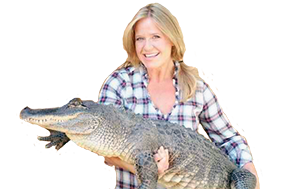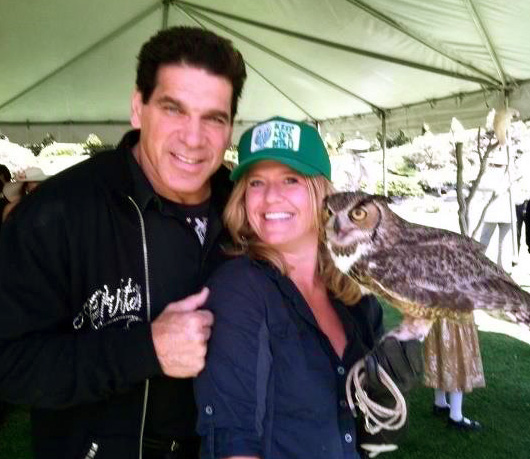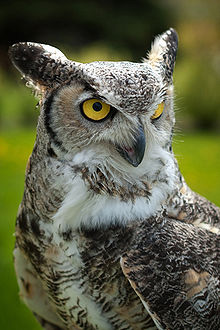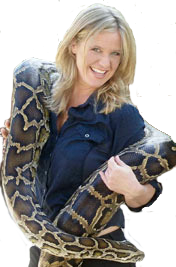 | Kangaroo LanieAmerica's Wild Girl | 
|
..And Her Animal Friends Seen at Events Nationwide | ||
|
| 

|
 `
`  `
` 



The Great Horned Owl, (Bubo virginianus), also known as the Tiger Owl, is a large owl native to the Americas. It is an adaptable bird with a vast range and is the most widely distributed true owl in the Americas.
Great Horned Owls are the largest and heaviest extant owl in Central and South America and are the second heaviest owl in North America, after the Snowy Owl. They range in length from 18-27 in (46-69 cm) and have a wingspan of 40-60.5 in (101-153 cm); Females are larger than males, an average adult being 22 in (55 cm) long with a 49 in (124 cm) wingspan and weighing about 3.1 lbs (1400 g). Depending on subspecies, Great Horned Owls can weigh from 0.72 to 2.55 kg (1.6 to 5.6 lb).
Adults have large ear tufts, a reddish, brown or gray face and a white patch on the throat. The iris is yellow, except the amber-eyed South American Great Horned Owl. Its "horns" are neither ears nor horns, simply tufts of feathers. The underparts are light with brown barring; the upper parts are mottled brown. The legs and feet are covered in feathers up to the talons. There are individual and regional variations in color; birds from the sub-Arctic are a washed-out, light-buff color, while those from Central America can be a dark chocolate brown.
Their call is a low-pitched but loud ho-ho-hoo hoo hoo; sometimes it is only four syllables instead of five. The female's call is higher and rises in pitch at the end of the call. Young owls make hissing or screeching sounds that are often confused with the calls of Barn Owls.
Owls have spectacular binocular vision allowing them to pinpoint prey and see in low light. The eyes of Great Horned Owls are nearly as large as those of humans and are immobile within their circular bone sockets. Instead of turning their eyes, they turn their heads. Therefore, their neck must be able to turn a full 270 degrees in order to see in other directions without moving its entire body.
An owl's hearing is as good as - if not better than - its vision; they have better depth perception and better perception of sound elevation (up-down direction) than humans. This is due to owl ears not being placed in the same position on either side of their head: the right ear is typically set higher in the skull and at a slightly different angle. By tilting or turning its head until the sound is the same in each ear, an owl can pinpoint both the horizontal and vertical direction of a sound.
These birds hunt at night by waiting on a high perch and swooping down on prey. Prey can vary greatly based on opportunity. The predominant prey group are small to medium-sized mammals such as hares, rabbits, juvenile raccoons, rats, squirrels, mice, moles, voles, shrews, bats, armadillos, muskrats, weasels and gerbils. It is even a natural predator of prey two to three times heavier than itself such as porcupines, marmots and skunks. Birds also comprise a large portion of a Great Horned Owl's diet, ranging in size from kinglets to Great Blue Herons. Waterbirds, especially coots and ducks, are hunted; even raptors, up to the size of Red-tailed Hawk and Snowy Owls, are sometimes taken. Regular avian prey includes woodpeckers, grouse, crows, pigeons, herons, gulls, quail, turkey and various passerines. The Great Horned Owl is a potential predator of any other owl species found in the Americas, of which there are several dozen. Reptiles (to the size of young American alligators), amphibians, fish, crustaceans and even insects are only occasional prey. In addition, the Great Horned Owl will predate on domesticated cats and small or young dogs. It is common for people to deal with troublesome wildlife by placing plastic replicas of Great Horned Owls on their property, since many small animals will actively avoid areas inhabited by them.
These birds also have 200-300 pounds per square inch of crushing power in their talons. An average adult human male has about 60 pounds per square inch in his hands.In northern regions, where larger prey that cannot be eaten quickly are most prevalent, they may let uneaten food freeze and then thaw it out later using their own body heat. They also tend to eat and regurgitate food in the same locations.
They are amongst the world's most adaptable owls in terms of habitat. They can take up residence in trees that include deciduous, coniferous, and mixed forests, tropical rainforests, pampas, prairie, mountainous areas, deserts, subarctic tundra, rocky coasts, mangrove swamp forests, and some urban areas. It is less common in the more extreme areas (i.e., the heart of the deserts, extremely dense rainforests and in mountainous areas above tree line), generally absent from non-tidal wetland habitat, and missing from the high Arctic tundra. They prefer areas where open habitats, which they often hunt in, and woods, where they tend to roost and nest, are juxtaposed and thus rural regions can be ideal. All mated Great Horned Owls are permanent residents of their territories, but unmated and younger birds move freely in search of company and a territory, and leave regions with little food in winter.

Native to the rainforest of Central and South America - the sloth is a unique mammal. There are two types of sloths - the two toed sloth and the three toed sloth. The sloth is a strictly arboreal, or tree-dwelling, animal that only descends to the forrest floor about once a week to poop! Sloths hang upside down from tree branches using their very large claws. It is armadillos, anteaters, and sloths that make up what is referred to as "the claw family", called Xenarthra or Edentata. The sloth is known to move slowly through the branches as they eat the leaves, shoots, buds and some fruit. Their slow lifestyle and certain characteristics of their fur allow for varieties of algae, mosses, cyanobacteria, and insects to live in it! Because of this, a sloth is like a mini ecosystem!
While the sloth spends a great majority of its time hanging upside down from trees - they actually can walk and even swim! Unlike the other members of the claw family, the sloth does have modified sharp teeth that it uses to chew foliage and for defense. Predators of the sloth include jaguars, harpy eagles, and human beings. This peaceful animal is threatened in many areas due to poaching and habitat destruction.
 | Copyright 2012-2024, Kangaroo Lanie -- All Rights Reserved | 
|
..And Her Animal Friends Seen at Events Nationwide | ||
|
| ||
|
Make sure to visit the Conservation Ambassadors Website. |